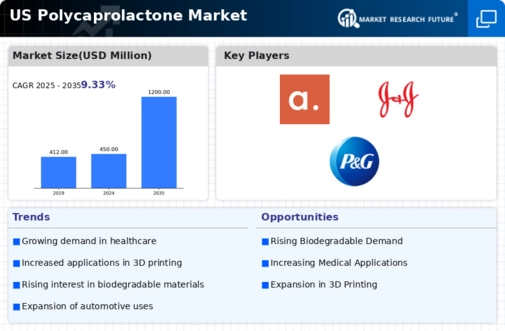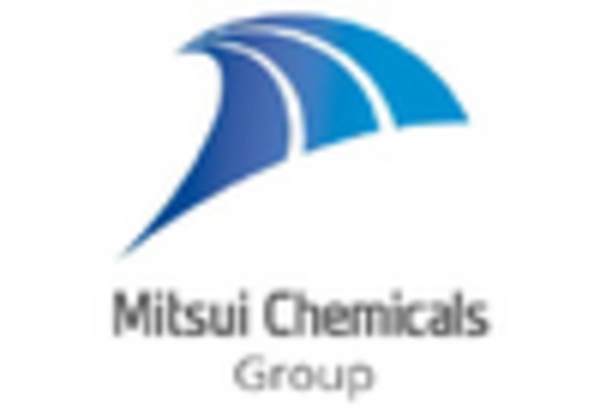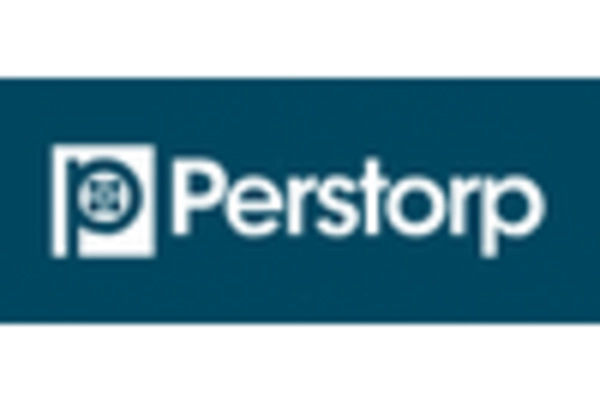Emerging Trends in Consumer Goods
The polycaprolactone market is influenced by emerging trends in consumer goods, particularly as brands increasingly adopt sustainable practices. Consumers are becoming more discerning, favoring products that are environmentally friendly and responsibly sourced. Polycaprolactone, with its biodegradable nature, aligns well with these consumer preferences. The US consumer goods market is expected to grow significantly, with sustainability being a key driver of this growth. As companies strive to meet consumer expectations, the incorporation of polycaprolactone into various products is likely to rise. This trend not only enhances brand reputation but also positions the polycaprolactone market as a vital player in the evolving consumer landscape.
Rising Demand in the Automotive Sector
The polycaprolactone market is witnessing increased interest from the automotive sector, driven by the industry's shift towards lightweight and sustainable materials. Polycaprolactone's properties, such as flexibility and durability, make it suitable for various automotive applications, including interior components and insulation materials. The US automotive market is projected to reach $1 trillion by 2025, with a growing emphasis on reducing vehicle weight to improve fuel efficiency. As manufacturers seek to incorporate more sustainable materials into their production processes, polycaprolactone is likely to gain traction. This trend not only supports environmental initiatives but also enhances the competitive edge of the polycaprolactone market in the automotive industry.
Growing Applications in Medical Devices
The polycaprolactone market is experiencing a surge in demand due to its expanding applications in the medical device sector. Polycaprolactone, known for its biocompatibility and biodegradability, is increasingly utilized in sutures, drug delivery systems, and tissue engineering. The market for medical devices in the US is projected to reach approximately $208 billion by 2025, with polycaprolactone playing a crucial role in this growth. As healthcare providers seek innovative materials that align with sustainability goals, the polycaprolactone market is likely to benefit from this trend. The material's unique properties, such as its ability to degrade in the body over time, make it an attractive option for various medical applications, thereby driving demand and fostering advancements in the industry.
Advancements in 3D Printing Technologies
The polycaprolactone market is benefiting from advancements in 3D printing technologies, which are revolutionizing manufacturing processes across various sectors. Polycaprolactone's favorable properties, such as low melting point and ease of processing, make it an ideal candidate for 3D printing applications. The 3D printing market in the US is projected to reach $32 billion by 2026, with polycaprolactone likely to capture a share of this growth. As industries explore innovative ways to produce customized products, the demand for polycaprolactone in 3D printing is expected to increase. This trend not only enhances the versatility of the material but also positions the polycaprolactone market as a critical component in the future of manufacturing.
Increased Focus on Sustainable Packaging Solutions
The polycaprolactone market is poised for growth as industries increasingly prioritize sustainable packaging solutions. With rising consumer awareness regarding environmental issues, companies are seeking alternatives to traditional plastics. Polycaprolactone, being biodegradable, offers a viable solution for packaging applications. The US packaging market is expected to grow to $1 trillion by 2026, with a significant portion likely to be driven by sustainable materials. As businesses strive to meet consumer demand for eco-friendly products, the adoption of polycaprolactone in packaging is anticipated to rise. This shift not only aligns with corporate sustainability goals but also positions the polycaprolactone market as a key player in the evolving landscape of packaging materials.

















Leave a Comment